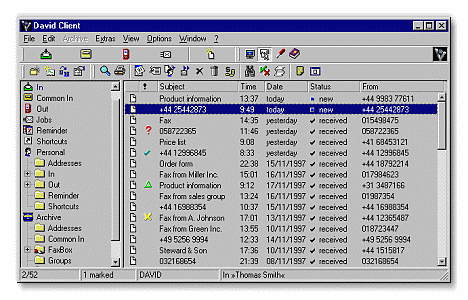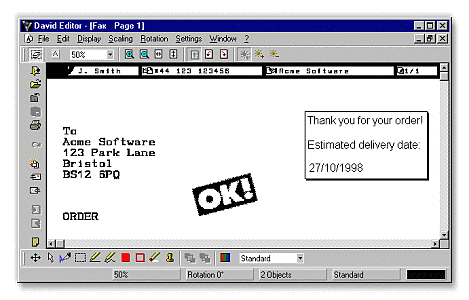RECEIVING FAXES
OK, you're right!
The most interesting thing about a good fax solution is primarily its fax
transmission features. However, the real power of FaxWare 5 starts where
other solutions have already given up! After all, you don't just want to
have a list of all outgoing faxes but also a list of all incoming documents.
You want to receive faxes direct to your desk. Often this is realized in
the second phase of an installation, but in fact there is no easier way
to do this than with FaxWare 5.á áá áá
Fax distributioná
No matter if
you work with ISDN or if you use analog modems, inbound faxes can be automatically
routed to the corresponding person or to an entire group on the network.
Leave the routing and printout of incoming faxes to FaxWare 5. No other
fax solution includes so many options for routing and working with inbound
faxes.áá
The distant
station's CSIDá
The calling
station ID or CSID identifies the fax number of the distant station. Simply
assign the corresponding recipient/recipient group to each CSID. This need
not be done all in one go when you install FaxWare, but as faxes are received
you can teach FaxWare how to deal with them next time round.áá
The receiving
lineá
If you use FaxWare
5 with several lines, a recipient group/recipient can be assigned to each
line.áá
MSN or DDIá
If you receive
faxes using ISDN you can use MSN or DDI to assign individuals, departments
or archives their own direct fax numbers. With ╗Multi Subscriber Number½
(MSN) you are limited to a maximum of 10 numbers. With ╗Direct Dial In½
(DDI) there is no limitation. Alternatively, the sender can use sub-addressing
to add an extension number to the actual fax number. This extension number
will be recognized by the ISDN board. After that, the Service Layer routes
directly to a user, a group, or to the Tobit Archive System. The sub-addressing
feature is only available with ISDN and its implementation varies by country.áá
DIDá
Distribution
by means of direct dialing. This is a suffix (DTMF) to the number dialed.
The DID suffix has to be dialed after the connection has been made. This
method is not widely used in Europe, but is popular in the USA and Canada.
DID routing is not possible with all fax hardware.If you want to use DID
routing please check the requirements first with your reseller.áá
Automatic
printoutá
For each user
you can individually define where the hard copy is to be printed. Simply
assign the available network print queues of your server to each user or
to each individual group. If desired, a graphic banner will appear on the
sides of each printout, to distinguish faxes from other documents.áá
Status reportá
You wish to
be informed on your workstation when a fax is received? No problem! Depending
on the configuration, each user can automatically receive a broadcast message.
Under Windows you could also use the Tobit Message Reminder included as
standard for automatic notification. When you're not in the office, a suitable
SMS message can be sent to your cellular phone telling you that you have
received a fax and who it is from.áá
Routing received
faxesá
You probably
recognize this problem. You are not in the office for a few days and nobody
takes care of your faxes. Not with FaxWare! In the archive configuration,
you can simply enter another recipient on the network or another fax number.
For example, this way, your messages could be routed directly to your home.
Messages received can be routed automatically to a new destination or copies
of these messages can be distributed. It's possible to route all incoming
messages (for example to your substitute) or to use the different filtering
options, which can be logically connected with each other, for further
rule based routing. Each user can configure the routing options for their
archive from their client without requiring the administrator's help. With
this tool, you can configure the complete message routing on the network
independently of the routing rules set on the FaxWare Service Layer.áá
Securityá
An important
question is who can view your faxes? In addition to network rights, the
system supervisor can assign extra privileges to each FaxWare user. These
include the ability to view all faxes, the option to route received messages
and the power to access the FaxWare console remotely.áá
Editing received
faxesá
You certainly
know this problem! You receive a fax, add some hand-written notes directly
onto the document and fax it back to the sender. Of course, you have to
use a manual fax machine! Not with FaxWare 5. A received fax can be edited
under Microsoft Windows in the fax viewer. Simply display the fax and insert
text or graphic objects at anywhere in the document. The integrated fax
viewer has many useful editing tools, e.g. text fields with all installed
Window's font types, frames, boxes, graphical stamps, etc. You can also
╗hide½ confidential information with this viewer. Simply erase the text
passage with the ╗rubber½ and send the fax to the recipient. With a single
mouse click you can now return the fax directly to the sender or specify
another fax number. However, you can also use colored markers to highlight
areas of text and route the fax internally to your colleagues.á Archiving: fax files can be saved from within the fax viewer to any directory.
The files can be saved in fax format as well as in bitmap format (BMP).
Of course, it is also possible to copy any sections of the fax and to paste
them into a graphic application by using the Windows clipboard.á
Archiving: fax files can be saved from within the fax viewer to any directory.
The files can be saved in fax format as well as in bitmap format (BMP).
Of course, it is also possible to copy any sections of the fax and to paste
them into a graphic application by using the Windows clipboard.á |
 á
á

 FaxWare
5
FaxWare
5 áá
áá
 Archiving: fax files can be saved from within the fax viewer to any directory.
The files can be saved in fax format as well as in bitmap format (BMP).
Of course, it is also possible to copy any sections of the fax and to paste
them into a graphic application by using the Windows clipboard.á
Archiving: fax files can be saved from within the fax viewer to any directory.
The files can be saved in fax format as well as in bitmap format (BMP).
Of course, it is also possible to copy any sections of the fax and to paste
them into a graphic application by using the Windows clipboard.á